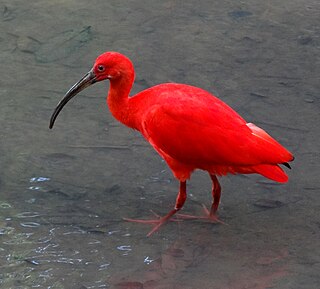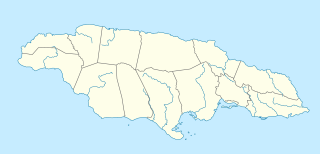Related Research Articles

The ibises are a group of long-legged wading birds in the family Threskiornithidae, that inhabit wetlands, forests and plains. "Ibis" derives from the Latin and Ancient Greek word for this group of birds. It also occurs in the scientific name of the cattle egret mistakenly identified in 1757 as being the sacred ibis.

The rails, or Rallidae, are a large cosmopolitan family of small- to medium-sized, ground-living birds. The family exhibits considerable diversity and includes the crakes, coots, and gallinules. Many species are associated with wetlands, although the family is found in every terrestrial habitat except dry deserts, polar regions, and alpine areas above the snow line. Members of the Rallidae occur on every continent except Antarctica. Numerous island species are known. The most common rail habitats are marshland and dense forest. They are especially fond of dense vegetation.

Anas is a genus of dabbling ducks. It includes the pintails, most teals, and the mallard and its close relatives. It formerly included additional species but following the publication of a molecular phylogenetic study in 2009 the genus was split into four separate genera. The genus now contains 31 living species. The name Anas is the Latin for "duck".

Struthio is a genus of birds in the order Struthioniformes, whose members are the ostriches. It is part of the infraclass Palaeognathae, a diverse group of flightless birds also known as ratites that includes the emus, rheas, and kiwis. There are two living species of ostrich, the common ostrich and the Somali ostrich.

Plotopteridae is the name of an extinct family of flightless seabirds from the order Suliformes. Related to the gannets and boobies, they exhibited remarkable convergent evolution with the penguins, particularly with the now extinct giant penguins. That they lived in the North Pacific, the other side of the world from the penguins, has led to them being described at times as the Northern Hemisphere's penguins, though they were not closely related. More recent studies have shown, however, that the shoulder-girdle, forelimb and sternum of plotopterids differ significantly from those of penguins, so comparisons in terms of function may not be entirely accurate.

Mycteria is a genus of large tropical storks with representatives in the Americas, east Africa and southern and southeastern Asia. Two species have "ibis" in their scientific or old common names, but they are not related to these birds and simply look more similar to an ibis than do other storks.

The Lance (Creek) Formation is a division of Late Cretaceous rocks in the western United States. Named after Lance Creek, Wyoming, the microvertebrate fossils and dinosaurs represent important components of the latest Mesozoic vertebrate faunas. The Lance Formation is Late Maastrichtian in age, and shares much fauna with the Hell Creek Formation of Montana and North Dakota, the Frenchman Formation of southwest Saskatchewan, and the lower part of the Scollard Formation of Alberta.

Eudocimus is a genus of ibises, wading birds of the family Threskiornithidae. They occur in the warmer parts of the New World with representatives from the southern United States south through Central America, the West Indies, and South America.

Titanis is an extinct genus of giant flightless terror birds that inhabited North America during the early Pliocene to early Pleistocene epochs. The generic name, Titanis, refers to the titans, Ancient Greek gods that preceded the Twelve Olympians, in allusion to the bird's size. The specific name, T. walleri, honors the holotype's collector, Benjamin I. Waller, an avocational underwater archaeologist. Titanis was thought to be carnivorous and most likely preyed on the many small mammals of the time period. This giant flightless bird was one of the most efficient predators of its time in North America.

Tyto pollens was an extinct giant barn owl which lived in the Bahamas during the last Ice Age.

Jackson's Bay Cave is a very large cave system on the Portland Ridge in Clarendon near the south coast of Jamaica. It is considered to be one of the most beautiful in the Caribbean. It was discovered in 1964. Over 10 kilometres of caves have since been mapped.
Paleontology or palaeontology is the study of prehistoric life forms on Earth through the examination of plant and animal fossils. This includes the study of body fossils, tracks (ichnites), burrows, cast-off parts, fossilised feces (coprolites), palynomorphs and chemical residues. Because humans have encountered fossils for millennia, paleontology has a long history both before and after becoming formalized as a science. This article records significant discoveries and events related to paleontology that occurred or were published in the year 1977.
Paleontology or palaeontology is the study of prehistoric life forms on Earth through the examination of plant and animal fossils. This includes the study of body fossils, tracks (ichnites), burrows, cast-off parts, fossilised feces (coprolites), palynomorphs and chemical residues. Because humans have encountered fossils for millennia, paleontology has a long history both before and after becoming formalized as a science. This article records significant discoveries and events related to paleontology that occurred or were published in the year 1976.
Paleontology or palaeontology is the study of prehistoric life forms on Earth through the examination of plant and animal fossils. This includes the study of body fossils, tracks (ichnites), burrows, cast-off parts, fossilised feces (coprolites), palynomorphs and chemical residues. Because humans have encountered fossils for millennia, paleontology has a long history both before and after becoming formalized as a science. This article records significant discoveries and events related to paleontology that occurred or were published in the year 1973.
Paleontology or palaeontology is the study of prehistoric life forms on Earth through the examination of plant and animal fossils. This includes the study of body fossils, tracks (ichnites), burrows, cast-off parts, fossilised feces (coprolites), palynomorphs and chemical residues. Because humans have encountered fossils for millennia, paleontology has a long history both before and after becoming formalized as a science. This article records significant discoveries and events related to paleontology that occurred or were published in the year 1963.

Hesperotestudo is an extinct genus of tortoise that lived from the Miocene to the Pleistocene. Its remains are known from North America, Central America and Bermuda. Further specimens identifiable only to genus have been found in El Salvador.

The Jamaican ibis, Jamaican flightless ibis or clubbed-wing ibis is an extinct bird species of the ibis subfamily uniquely characterized by its club-like wings. It is the only species in the genus Xenicibis, and one of only two flightless ibis genera, the other being the genus Apteribis endemic to Hawaii.

Swansea Cave is a cave and palaeontological site in the Saint Catherine Parish of south-eastern Jamaica.
References
Notes
Sources
- Longrich, Nicholas R. & Olson, Storrs L. (2010). "The bizarre wing of the Jamaican flightless ibis Xenicibis xympithecus: a unique vertebrate adaptation". Proceedings of the Royal Society B. 278 (1716): 2333–2337. doi:10.1098/rspb.2010.2117. PMC 3119002 . PMID 21208965.
- McFarlane, Donald A. & Blake, Jerome. (2005). "The late Pleistocene hutias (Geocapromys brownii) of Red Hills Fissure, Jamaica" (PDF). Geological Journal. 40 (3): 399–404. doi:10.1002/gj.1010.
Coordinates: 18°04′N76°52′W / 18.067°N 76.867°W
| This paleontological site article is a stub. You can help Wikipedia by expanding it. |
| This Jamaican location article is a stub. You can help Wikipedia by expanding it. |